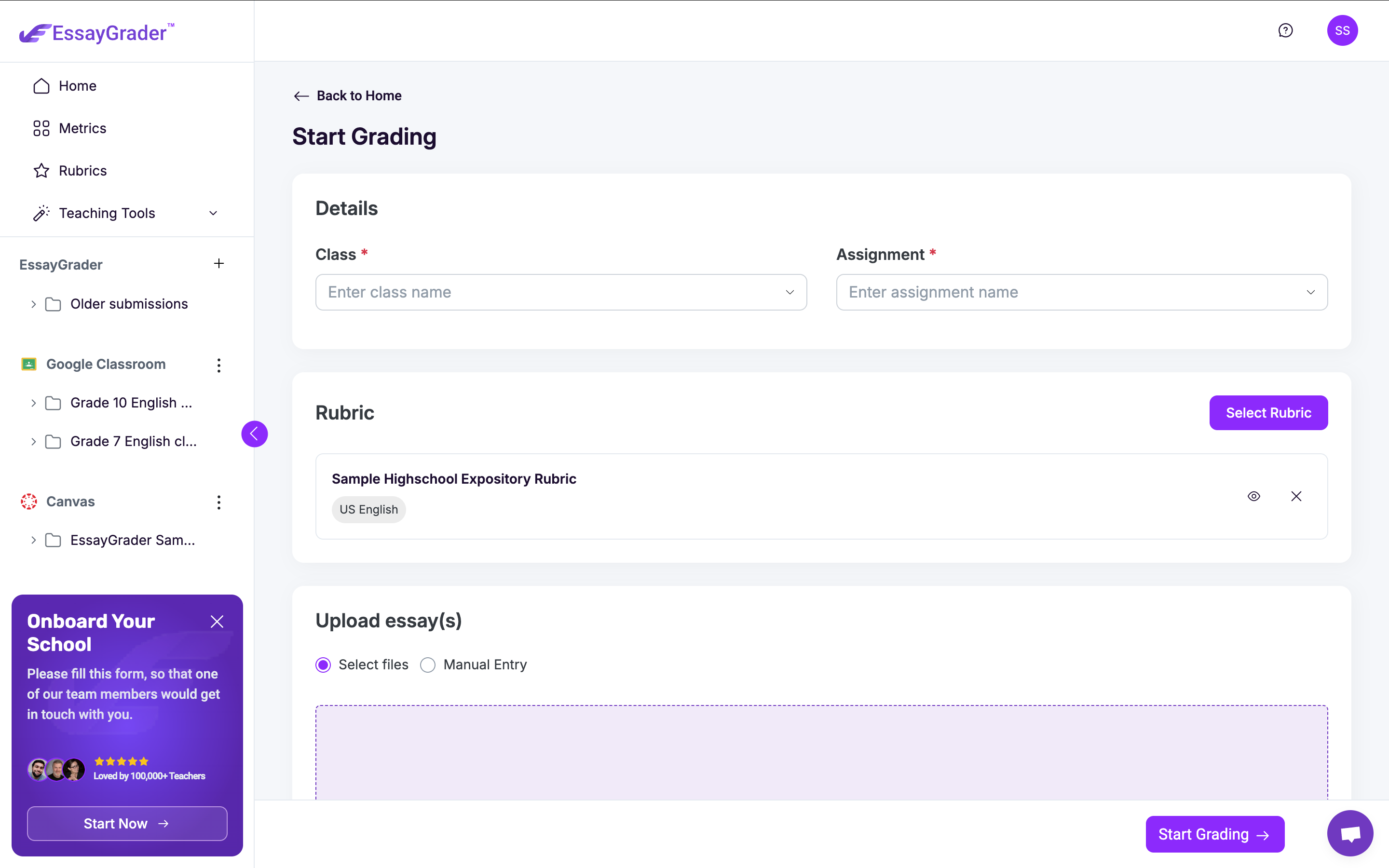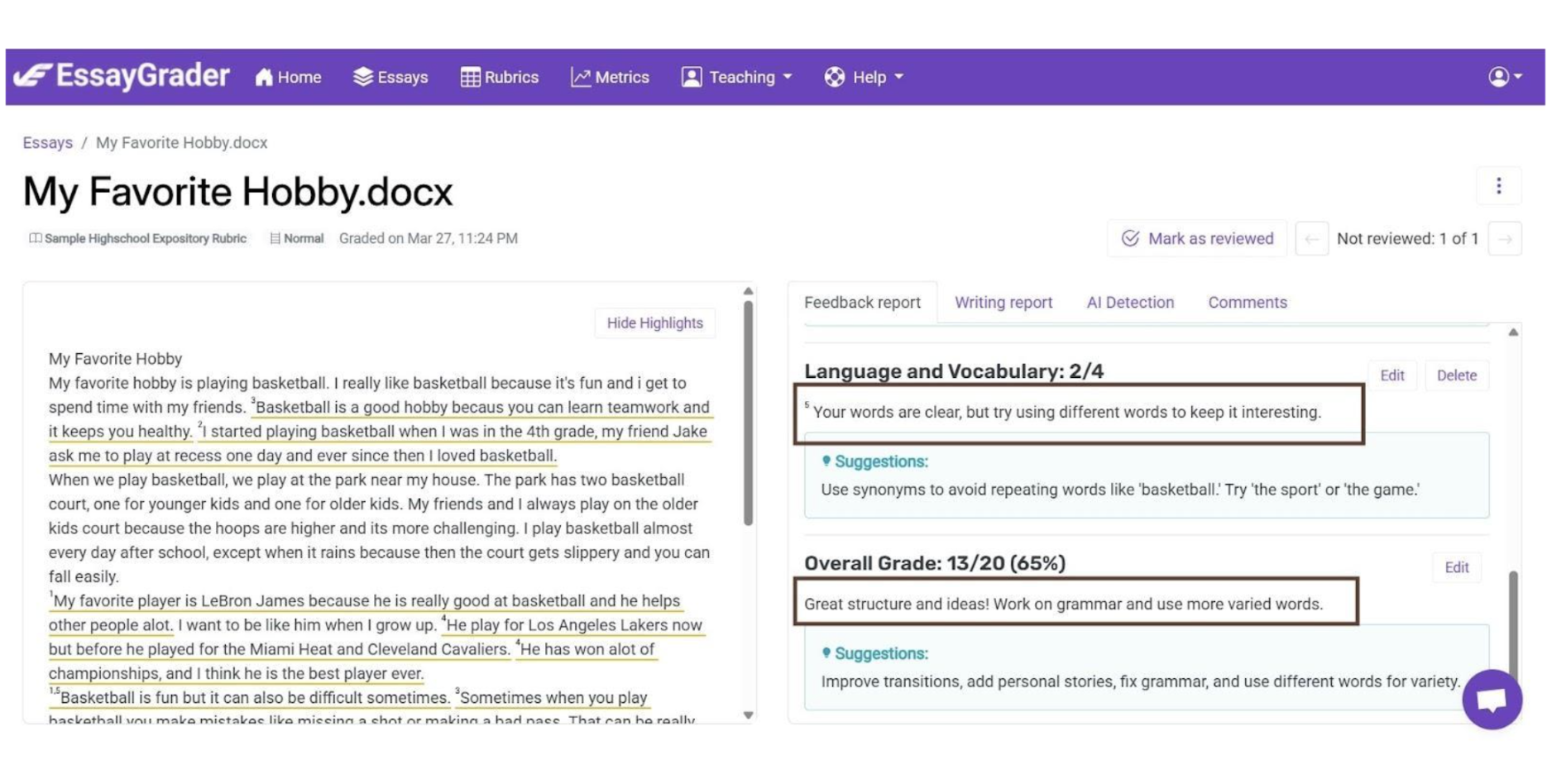Grading takes time...
Sometimes more time than teachers actually have. Between lesson plans, parent emails, and even hallway duty, teachers already have their hands full. Pile on stacks of essays and assignments, and suddenly evenings vanish and weekends get swallowed up by grading and red ink.
But, that’s where AI is beginning to change the equation. A recent Gallup survey found that teachers who use AI tools regularly save up to six hours per week — nearly a month and a half of time back across a school year. That kind of relief isn’t just convenient, it’s the difference between burnout and balance.
And while teachers are just beginning to explore AI in their work, students are already embracing it at a staggering pace. Reports suggest that more than 8 in 10 students globally use AI regularly for homework, essays, and studying.
That shift makes grading tougher than ever. Teachers don’t just need tools that save them time, they need tools that also keep grading fair and protect academic integrity.
And the edtech industry knows it. The AI in education sector was valued at $5.9 billion in 2024 and is projected to grow to $32.3 billion by 2030. This isn’t a passing trend, it’s truly the future of assessment.
Which is why choosing the best grading tool really matters. The right one can give teachers back hours in their week, keep feedback consistent, and support real learning. The wrong one? It creates more clicks, more confusion, and more headaches.
That’s why we’ve created this guide to help you understand not only why you need these tools, but what to look for. In this guide, you’ll find:
- Questions to ask before investing in an AI grading tool
- Why each one matters for your teachers, students, and district
- What to look for in an AI grading tool and what to avoid
- Tips to help you have a smooth rollout from day one

Question 1 to Ask: Does the tool natively integrate with our existing LMS?
If teachers are already spending most of their day inside Google Classroom, Canvas, or Schoology, the last thing they want is to add yet another disconnected platform to their workload.
A grading tool should work where teachers already are.
According to Education Week, approximately 94% of districts use at least one major LMS (EdWeek, 2022). This means an AI tool’s ability to easily integrate integration isn’t optional, it’s essential.
The problem, however, comes when vendors rely on “middleware”, which are third-party connectors that sit between the grading tool and the LMS.
That extra step might not sound like a big deal, but it opens up the door for delays, sync errors, and new data privacy concerns.
What to look for: Ask vendors if they offer direct, certified integrations with your district’s LMS. Request a live demo where they import assignments, sync rosters, and export grades in real time. And talk to other districts already using the tool. Find out if teachers say the integration actually works in practice.
Question 2 to Ask: How accurate and consistent is the grading?
Accuracy is the backbone of any grading tool. If the AI can’t match human judgment reliably, teachers will stop using it. Now, there’s actually solid evidence behind the best automated scoring systems. ETS research has shown that top-tier engines can align with trained human graders at rates around 95 to 97 percent. That’s promising, but not every tool performs at that level.
The risk you face is inconsistency. Imagine a tool that grades the same essay differently on Monday than it does on Wednesday. Or one that grades a student’s writing more harshly simply because it doesn’t recognize dialect, voice, or non-traditional phrasing. These issues not only frustrate teachers but also erode trust in the system. And once trust is gone, adoption follows.
Question 3 to Ask: Does the platform support your state’s curriculum standards?

Every district has its own standards to follow, whether that’s Common Core, STAAR, B.E.S.T., Regents, IB, or something local.
If an AI tool doesn’t line up with those frameworks right away, teachers end up spending extra hours tweaking assignments and assessments just to make it fit. By that point, the whole idea of saving time with automation is lost.
However, even when the standards are supported, rubrics can still be the stumbling block. Many schools use rubrics that are too general for AI to interpret well.
Broad statements like “student demonstrates strong reasoning” might work for a teacher who knows the context, but for AI, it’s much too vague. A lack of detailed information leaves AI to guess. And guessing is not grading.
Question 4 to Ask: Does the tool include AI writing detection and plagiarism checking?
In this day and age, this is no longer just a “nice to have.” As previously mentioned, with 86% of students globally using AI regularly, schools can’t rely on old plagiarism checkers alone.
Why does this matter? Because teachers are finding it harder and harder to tell when work is original. And that creates an uneven playing field. Students who do their own writing (sans AI assistance) can feel penalized when others rely too heavily on AI.
And this isn’t just about one essay here or there. If schools can’t show they’ve got a handle on AI use, it can chip away at parent trust, make it harder to hold students accountable, and even raise questions about whether grades still mean what they should. That’s why this question matters so much. If a grading tool doesn’t take AI writing and plagiarism seriously, it won’t fix the problem. It’ll just add to the mess.
However, the tricky part, when it comes to all of this, is nuance. As educators, it’s important to understand that not every use of AI is cheating.
Plenty of students turn to it for brainstorming or polishing their ideas, which isn’t the same as handing in something the AI wrote start to finish. If a tool treats every bit of AI use as plagiarism, it just creates frustration and mistrust between teachers and students.
That’s why the best tools go beyond throwing out scary percentages or confusing charts. Instead, they provide clear, actionable flags so teachers can quickly see what needs a closer look and start a fair conversation with students.
Question 5 to Ask: How easy is it to use the AI tool?
Over the past few years, schools have seen an explosion of digital tools. School districts went from using a few hundred edtech platforms in 2018 to more than 2,700 by the 2023/24 school year.
With this boom, it’s obvious teachers already juggle dozens of platforms, apps, and logins. That’s why, if a tool feels complicated or slows teachers down, it’s less likely to stick. Interestingly, even with new AI models rolling out, more training opportunities, and a summer to reset, adoption dipped from 33% in December 2023 to 32% in October 2024.
It’s a small shift, but it shows that ease of use really matters. And ease of use isn’t just about a clean design. It’s about the everyday workflow.
How long does it take to grade a full class set of essays? How many steps are needed to leave feedback? And when the AI misses something, can a teacher quickly step in and make changes without breaking their stride?
Question 6 to Ask: Is the AI tool trained using your students’ work and assignments?
Some companies quietly use student writing to train their systems. At first glance, that might not sound like a big deal. But once that work is fed into someone else’s model, the school has no control over where it goes or how it might show up later.
That’s a problem for a few reasons.
Depending on the assignment, some student essays can include personal details about their families, their lives, and even their health. That information was only ever meant for their teacher’s eyes, and not so that it could to live inside a tech company’s database.
It also raises a fairness issue: why should kids’ work be used to make a vendor’s product better without their permission?
And beyond all that, there’s trust. If parents find out their child’s writing is being stored or reused in ways they didn’t agree to, it puts the whole district in a bad light. Once that trust is broken, it’s tough to get it back.
Question 7 to Ask: Does the AI tool store personal student and staff data — and how is it protected?
Data breaches, unfortunately, aren’t just hypothetical. In fact, ransomware attacks against schools, colleges, and universities went up 23% in the first half of 2025. That makes it more important than ever to know exactly how your data is being handled.
When a breach happens, it’s not just an IT problem. Parents want reassurance that their child’s information is safe. Staff don’t want their personal details out in the open. And for a district, a single incident can mean big costs, long recovery times, and a hit to trust.
Question 8 to Ask: Is the vendor compliant with FERPA, COPPA, SOC 2 — and will they sign your district’s Data Privacy Agreement (DPA)?
Protecting data isn’t just about keeping it safe from hackers. It’s also about making sure vendors follow the regulations and laws schools have to follow. FERPA is the federal law that protects student records, and COPPA is the one that limits what companies can collect from kids under 13. Any company working with schools must meet both requirements, without question.
But laws aren’t enough on their own. You also need proof that a vendor’s systems are actually secure. That’s where SOC 2 audits or NIST cybersecurity reviews come in.
These are outside checks that show whether a company really protects data the way they say they do. The important thing here is timing: an audit from years ago doesn’t mean much. Always ask for the most recent report, and have your IT or legal team take a look over everything before you sign.
You’ll also need a Data Privacy Agreement (DPA). This is a contract that lays out exactly how student data will be collected, stored, used, and deleted. Each state has its own version, and some districts add extra requirements. Consider it a red flag if a vendor hesitates or refuses to sign one.
Question 9 to Ask: Can the vendor train your staff? What does onboarding look like?
The best tool in the world won’t matter if teachers don’t feel comfortable using it.
Training is what makes or breaks adoption. In fact, just last year, 48% of districts reported they had trained teachers on AI use —up from just 23% the year before.
That’s progress, but it also means more than half of districts still haven’t given teachers any actual structured support to help navigate these tools.
When teachers don’t get training, they usually fall back on old habits or stop using the tool altogether. That means districts spend money on something that never really gets used, and students miss out on the benefits. But when training is offered and accessible, teachers actually use the tool — and they use it the right way. When it comes to AI grading tools, this leads to more consistent grading and better outcomes for students.
Training also can’t be a one-time demo. Just like students, each teacher has a different way they like to learn.
Consider live sessions when they’re starting out, recordings they can watch later, and vendors with a support team they can count and reach out to when questions come up during the year. It also helps when districts connect this training to professional development credits, so teachers see it as part of their growth and not just another thing on their plate.

How EssayGrader AI Stacks Up Against These Questions
The nine questions in this guide are worth asking because they cut through the sales pitch. They get to the heart of whether an AI grading tool is going to save time or simply add more work.
Teachers already have enough on their plates, which is why any grading tool has to fit naturally into the day-to-day. EssayGrader AI was created with that in mind. Our AI grading tool is designed for real classrooms, real teachers, and the real demands of today’s schools.
EssayGrader’s purpose is simple: help teachers get through grading faster while keeping things fair for students. It works inside the platforms schools already use, like Google Classroom and Canvas, so teachers don’t have to learn another system or juggle more logins.
Scores align closely with what a teacher would give, and rubrics can be adjusted to match local standards. Teachers can step in at any point to change a score, so they always stay in control. In fact, our AI platform cuts grading time by 80%.
Similarly, in testing, EssayGrader matched human graders 96% of the time, and those results have been independently validated, which is why organizations like Teachers of Tomorrow trust EssayGrader to handle grading at scale.
One of the biggest challenges today is figuring out when students lean too heavily on AI. EssayGrader doesn’t mark everything as AI-generated or plagiarism. Instead, it highlights the parts that might need a second look, giving teachers a fair and practical way to respond.
Privacy is also a priority. Student work isn’t used to train the system, sold to third parties, or turned into marketing data. All information is encrypted and handled under FERPA, COPPA, and SOC 2 standards, so schools know it’s protected.
And because no tool succeeds without good training, EssayGrader includes live onboarding, on-demand resources, and year-round support. Teachers aren’t left to figure it out alone. At the end of the day, EssayGrader turns hours of grading into minutes, giving teachers the one resource they never have enough of: time.
About EssayGrader
The #1 AI grading tool for K–12 teachers in the US
In the ever-demanding world of teaching, where teachers are stretched thin, EssayGrader stands as a beacon of relief, driven by a singular vision: lightening the grading burden for educators.
We know the challenges you face — like staring down a pile of 200 essays with just one of you to manage them all. It’s overwhelming, and we understand that better than anyone.
That’s why we built EssayGrader: It’s a straightforward, powerful tool that uses AI to take the load off your shoulders and completely change the way you approach grading.
Reach out to us at hello@essaygrader.ai and or visit www.EssayGrader.ai for more information.








.avif)
.avif)
